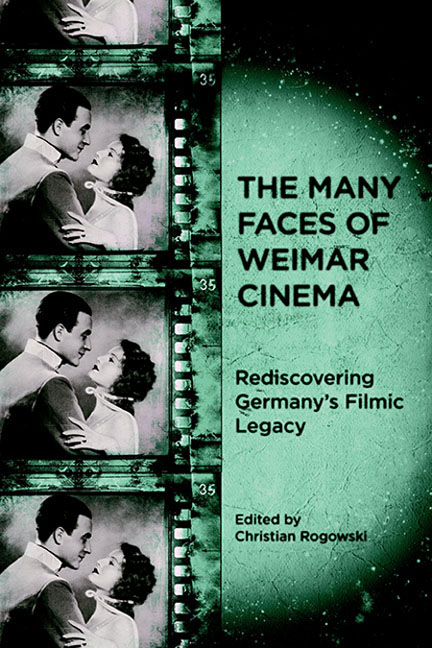Book contents
- Frontmatter
- Contents
- List of Illustrations
- Preface
- Introduction: Images and Imaginaries
- 1 Richard Oswald and the Social Hygiene Film: Promoting Public Health or Promiscuity?
- 2 Unsettling Nerves: Investigating War Trauma in Robert Reinert's Nerven (1919)
- 3 Humanity Unleashed: Anti-Bolshevism as Popular Culture in Early Weimar Cinema
- 4 Desire versus Despotism: The Politics of Sumurun (1920), Ernst Lubitsch's “Oriental” Fantasy
- 5 Romeo with Sidelocks: Jewish-Gentile Romance in E. A. Dupont's Das alte Gesetz (1923) and Other Early Weimar Assimilation Films
- 6 “These Hands Are Not My Hands”: War Trauma and Masculinity in Crisis in Robert Wiene's Orlacs Hände (1924)
- 7 The Star System in Weimar Cinema
- 8 Schaulust: Sexuality and Trauma in Conrad Veidt's Masculine Masquerades
- 9 The Musical Promise of Abstract Film
- 10 The International Project of National(ist) Film: Franz Osten in India
- 11 The Body in Time: Wilhelm Prager's Wege zu Kraft und Schönheit (1925)
- 12 Henrik Galeen's Alraune (1927): The Vamp and The Root of Horror
- 13 The Dialectic of (Sexual) Enlightenment: Wilhelm Dieterle's Geschlecht in Fesseln (1928)
- 14 Babel's Business — On Ufa's Multiple Language Film Versions, 1929–1933
- 15 “A New Era of Peace and Understanding”: The Integration of Sound Film into German Popular Cinema, 1929–1932
- 16 Landscapes of Death: Space and the Mobilization Genre in G. W. Pabst's Westfront 1918 (1930)
- 17 Undermining Babel: Victor Trivas's Niemandsland (1931)
- 18 Unmasking Brigitte Helm and Marlene Dietrich: The Vamp in German Romantic Comedies (1930–33)
- Filmography
- Notes on the Contributors
- Index
12 - Henrik Galeen's Alraune (1927): The Vamp and The Root of Horror
Published online by Cambridge University Press: 29 April 2017
- Frontmatter
- Contents
- List of Illustrations
- Preface
- Introduction: Images and Imaginaries
- 1 Richard Oswald and the Social Hygiene Film: Promoting Public Health or Promiscuity?
- 2 Unsettling Nerves: Investigating War Trauma in Robert Reinert's Nerven (1919)
- 3 Humanity Unleashed: Anti-Bolshevism as Popular Culture in Early Weimar Cinema
- 4 Desire versus Despotism: The Politics of Sumurun (1920), Ernst Lubitsch's “Oriental” Fantasy
- 5 Romeo with Sidelocks: Jewish-Gentile Romance in E. A. Dupont's Das alte Gesetz (1923) and Other Early Weimar Assimilation Films
- 6 “These Hands Are Not My Hands”: War Trauma and Masculinity in Crisis in Robert Wiene's Orlacs Hände (1924)
- 7 The Star System in Weimar Cinema
- 8 Schaulust: Sexuality and Trauma in Conrad Veidt's Masculine Masquerades
- 9 The Musical Promise of Abstract Film
- 10 The International Project of National(ist) Film: Franz Osten in India
- 11 The Body in Time: Wilhelm Prager's Wege zu Kraft und Schönheit (1925)
- 12 Henrik Galeen's Alraune (1927): The Vamp and The Root of Horror
- 13 The Dialectic of (Sexual) Enlightenment: Wilhelm Dieterle's Geschlecht in Fesseln (1928)
- 14 Babel's Business — On Ufa's Multiple Language Film Versions, 1929–1933
- 15 “A New Era of Peace and Understanding”: The Integration of Sound Film into German Popular Cinema, 1929–1932
- 16 Landscapes of Death: Space and the Mobilization Genre in G. W. Pabst's Westfront 1918 (1930)
- 17 Undermining Babel: Victor Trivas's Niemandsland (1931)
- 18 Unmasking Brigitte Helm and Marlene Dietrich: The Vamp in German Romantic Comedies (1930–33)
- Filmography
- Notes on the Contributors
- Index
Summary
Henrik Galeen's Alraune (Mandrake, 1927) is the tale of a dangerous vamp: inspired by a medieval myth in which the mandrake root at the base of the gallows becomes a living being after being fertilized by a hanged man and harvested at midnight, Professor ten Brinken creates a woman, artificially inseminating a prostitute with the semen from a hanged murderer. The product, Alraune, ruins every man who loves her and takes revenge on her maker, seducing and destroying him.
In his discussion of the vamp figure, conservative film critic Oskar Kalbus cites Brigitte Helm's Alraune as the prime example. To Kalbus, writing in 1935, the vamp is a “contemporary” phenomenon that unites pleasure and horror and hides traces of her difference from normal women. He compares the vamp to a vampire, an Indian dancer, and a gypsy — with “glowing eyes” and “snakelike movements” (129) — construing her as monstrous and racially other. In contrast to a healthy woman, the vamp does not love, but rather cruelly uses her strengths to reach her goals; her difference from others, however, is hard to see, for the vamp can be blonde and blue-eyed (Kalbus, 129) — accepted signs of Northern European racial identity at the time.
Kalbus's account inspires many of the questions central to this inquiry: How and why does Alraune make the vamp an object of horror? What is the relationship between Alraune and contemporary discourses of sex, race, and health? And what is the significance of the problem that the vamp cannot be distinguished visually from the healthy woman? By combining a close reading with attention to discussions of race, heredity, and the New Woman in the Weimar era, theories of the horror film, and Sigmund Freud's “Uncanny,” I will show how Alraune preys on fears of racial pollution and anxieties about the New Woman and debunks science as an effective source of knowledge.
The first scene of Alraune prepares spectators for a horror film. Titles narrating the Alraune legend alternate with abstract, distorted images of a gallows and cemetery, obscured by fog and high-contrast lighting.
- Type
- Chapter
- Information
- The Many Faces of Weimar CinemaRediscovering Germany's Filmic Legacy, pp. 198 - 210Publisher: Boydell & BrewerPrint publication year: 2010

